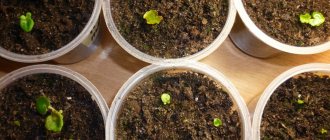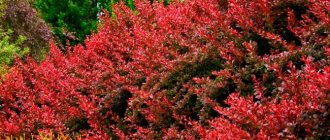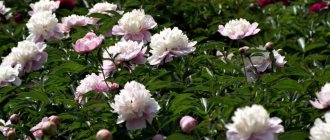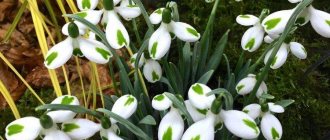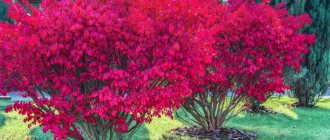The perennial herbaceous plant bergenia, or bergenia, is a representative of the Saxifraga family. In nature, such a plant can be found in the temperate zone from the countries of Central Asia to China and Korea; it prefers to grow on rocky soil and in rock cracks. This plant appeared in culture in the mid-18th century under the name “saxifrage thick-leaved”; later it was isolated into a separate genus and given a Latin name in honor of Carl August von Bergen, who was a German botanist. The genus Bergenia includes 10 species, some of which are cultivated by gardeners. In addition, thanks to breeders, several dozen different hybrids and varieties of bergenia were born.
Brief description of cultivation
- Landing . Bergenia seeds are sowed for seedlings before winter in boxes, seedlings are picked in the first days of June, and seedlings are planted in open soil in early August. If desired, the most powerful seedlings can be planted directly into the garden in early June, without diving.
- Bloom . Depending on the species, flowering times may vary; some of them begin to bloom in the last days of April. Flowering duration is approximately 6 weeks.
- Illumination . Grow in a slightly shaded area, but an area with bright, diffused light is also suitable.
- Soil . Suitable soil should be loose, light, moist and slightly alkaline.
- Watering . If the season is dry with little rain, then the flowers are watered for the first time during the formation of buds, then when they bloom, and the last time after 15–20 days. If it rains regularly, then there is no need to water the bergenia.
- Fertilizer . The first feeding is in early spring after the bush is pruned, the second is 15 days after the bergenia fades. For feeding, mineral complex fertilizer in liquid form is used.
- Reproduction . By dividing the bush and seed method.
- Harmful insects . Nematodes and slobbering pennies.
- Diseases . Ramulariasis.
- Properties . In such a herbaceous perennial, the rhizome has healing properties. Products made from it have a hemostatic, antimicrobial, astringent, anti-inflammatory, wound-healing and diuretic effect.
Care
Caring for bergenia is not at all problematic. In autumn, dry inflorescences should be removed, and overwintered leaves should be cut off in spring. In the first season after planting bergenia (no matter by seedlings or dividing the bush), the ground should be mulched. It should be watered only as needed, without allowing the soil to dry out. The healing healer is responsive to the application of mineral supplements. In the spring it can be fed with universal fertilizer: “Kemira Lux”, and in the fall it can be watered with a solution of superphosphate fertilizer at the rate of 20 g per bucket for watering 1 m² of soil.
Features of bergenia
The genus Bergenia is represented by evergreen herbaceous perennials and annuals. The height of the bushes, whose rhizomes are thick and horizontal, can vary from 6 to 35 centimeters. Large, glossy, leathery to the touch leaf plates are collected in a basal rosette; they have long petioles and a dark green color. Dense paniculate inflorescences consist of goblet-shaped flowers of pink, red or white. Flowering begins in the last spring or first summer weeks. One inflorescence can contain about 120 flowers. The fruit is a capsule with seeds.
In landscape design, this flower looks great against a background of stones next to narrow-leaved or variegated plants (for example, phlox or hosta).
Unpretentious plants for the Badan garden. Website "Garden World"
Use in landscape design
Colorful varieties of bergenia are suitable for forming multi-level flower beds of medium and large dimensions. Bergenia is planted more often at the foot or on the penultimate step. In the shade, the crop produces juicy and large foliage, in the sun it pleases with abundant flowering, the leaves are less lush.
The perennial shows itself best when decorating paths, the foreground of flower beds and flower beds, as an evergreen ground cover, an element of large mixborders. Saxifraga is also used as a tapeworm, placing the plant against the backdrop of a well-groomed emerald lawn. In autumn, the culture attracts attention to the changes in green and red tones.
With proper care, bergenia actively grows and delights with colorful flowering.
Growing bergenia from seeds
Sowing
Sowing of bergenia seeds is carried out before winter. To do this, the box is filled with a flower soil mixture, in which shallow grooves (about 0.5 cm) are made; the distance between them should be at least three centimeters. The grooves are shed with water, the temperature of which is slightly above room temperature, after which the seeds are evenly distributed in them and sealed. Take the crops out into the garden and bury them in the snow. They bring the box into the house in the first days of March and place it in a shaded, cool (18 to 19 degrees) place.
Growing seedlings
The first seedlings should appear after about 20 days. The seedlings must be watered in a timely manner as the top layer of the substrate dries, systematically loosen it, and also, if necessary, thin out the grown plants and regularly ventilate the room where the seedlings are located. If a green coating or crust appears on the surface of the substrate, then you should very carefully loosen the substrate, since this causes very poor oxygen supply to the root system of the plants. And a crust appears as a result of too much watering.
Picking seedlings
The picking of bergenia seedlings is carried out in May. For this, a larger box is used, and a distance of 50 to 70 mm should be maintained between seedlings, and the distance between rows should be about 15 centimeters.
When about half a month remains before transplanting the seedlings into the garden, you should begin hardening them off. To do this, the seedlings are taken out into fresh air every day, and the duration of this procedure is gradually increased. As soon as the seedlings can be in the fresh air around the clock, they are transplanted into the garden.
Growing a perennial plant
Most often, seeds are chosen for planting Badan.
Growing bergenia from seeds
Seeds are planted in winter.
- A box or other container is filled with a special soil mixture for flowers;
- Make shallow grooves, about half a centimeter. The distance between is three centimeters;
- Water the grooves with warm water;
- The seeds are carefully laid out and covered with earth;
- The box is buried in the snow in the garden;
- At the beginning of summer, the box is taken out and taken to a cool room.
Growing seedlings
Sprouts appear in the next three weeks. When the top layer of soil dries out, you need to promptly water the plants. The soil must be constantly loosened and the room ventilated. Plants are thinned out.
Excessive watering causes a greenish crust to appear on the surface of the soil. You need to immediately loosen the soil to supply oxygen to the roots.
Planting bergenia in open ground
What time to plant
Planting and growing bergenia in your garden plot is relatively simple. The fact is that this culture is unpretentious and frost-resistant. Seedlings are planted in open ground in the first days of August. However, some gardeners believe that seedlings should be planted in the garden at the beginning of summer, but there is no need to pick them. But what most often happens is that most of the plants turn out to be too weak to grow in open soil. In this regard, only the strongest and most developed bushes can be planted in open ground at the beginning of summer, and the rest are picked and grown at home until August, and only then are they transplanted into the garden.
Landing Features
The rhizome of bergenia is very weak and is located horizontally. In this regard, for its cultivation, areas with loose, light and moist soil of a slightly alkaline reaction are chosen. Often the plant's rhizome protrudes from the soil, which can lead to its overheating in direct sunlight. In this regard, a suitable site should be located in a slight shade on the north-west, north or north-east side of the garden. If you still choose a sunny area to plant bergenia, then you will need to cover the surface of the soil around the bushes with a layer of mulch, which will help prevent the rhizome from overheating and will also slow down the drying out of the soil. When choosing a site, you need to take into account the fact that the plant reacts extremely negatively even to short-term stagnation of liquid in the root system.
Planting holes are made in the selected area, the depth of which should be from 60 to 80 mm. They are placed in a checkerboard pattern of 40x40 centimeters. A handful of sand is poured into the bottom of each hole. After this, the plants are carefully transferred into them; you need to take them along with a lump of earth, fill the holes with soil. Planted plants need to be watered.
You must be prepared for the fact that the development of such a plant is extremely slow. The first flowering of bushes grown from seeds will occur only in the third or fourth year.
Bergenia thickleaf: planting in open ground. How to plant bergenia in spring
Sowing seeds
It is recommended to sow bergenia before winter. Choose a suitable box and fill it with flower soil. Next, it is necessary to make grooves in the soil, the depth of which should not exceed five millimeters. The distance from one groove to another should be three centimeters. After they are ready, you should spill them with warm water, and then lay out the seeds and immediately sprinkle them with soil. After planting, the box must be taken outside and placed under the snow. At the beginning of March, it will need to be brought indoors and placed in partial shade. The air temperature in the room should not fall below +18-19 degrees.
Caring for bergenia in the garden
Most often, if the rules of agricultural technology are followed, growing bergenia in open soil does not cause any special trouble to the gardener. In the spring, after the snow cover has melted, you need to cut off all the foliage from the bushes that was damaged during the winter. Also at this time, heavily overgrown stems are pruned and fertilized with complex mineral fertilizer. The plant is fed again half a month after the end of flowering, at which time new foliage should begin to grow. A solution of Kemira-combi fertilizer is suitable for feeding bergenia (1 tablespoon per 1 bucket of water). For 1 square meter of flower bed, take 5 liters of this solution.
Watering
In order for a flower to grow and develop normally, it must be watered correctly. The bushes are watered the first time after the buds begin to form, the second time during flowering, and the third time 15–20 days after the plants have finished flowering. However, it is necessary to water the bergenia only if the season is dry. If it rains regularly, then the flowers will have enough natural precipitation.
The roots of such a flower protect its lower leaf plates from overheating and drying out in nature, which eventually die and fly off. But when growing in the garden, in order to preserve the decorative appearance of the bushes, the leaf plates that have begun to die are torn off along with the petioles, and the soil surface is covered with a layer of mulch.
Reproduction by dividing the bush
Bergenia can be propagated not only by seeds, it can also be done by dividing the bush. An overgrown bush forms young rosettes with its own root system, which is located very close to the soil surface. That is why it is very simple to dig up and transplant a young rosette without injuring the parent plant. Only a healthy, well-developed, middle-aged bush with large leaf blades can be divided, and the leaf rosette is separated along with the heel. Make sure that there are three or more buds on each section of the rhizome. The division is carried out after the bushes have flowered: in May–August. On the cut rosette, only 2 or 3 of the youngest leaf plates should be left, and all the rest should be torn off. They are planted in pre-prepared planting holes, and they need to be buried 30–50 mm into the soil, and the distance between the divisions should be from 30 to 40 centimeters. The planted cuttings quickly take root. During the first year after transplantation, the rosette grows foliage, and the young bush will bloom only after the 2nd or 3rd year of growth.
